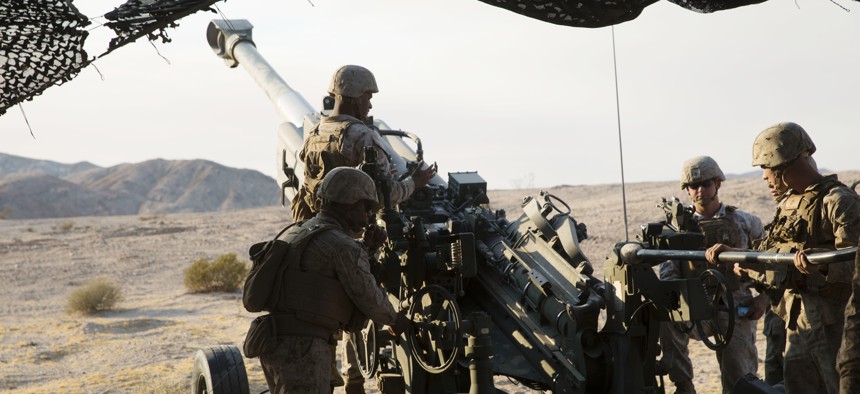
Marines prepare to fire an M777A2 howitzer during an excercise at the at Marine Corps Air-Ground Combat Center Twentynine Palms, Calif., Aug. 16, 2016. U.S. MARINE COPRS / SGT. ABBEY PERRIA
Boeing Wants to Patent a Fire-Fighting Howitzer Round
Suppressent-filled shell would help firefighters gun down wildfires.
The best way to fight fires may just be to shoot them. Boeing — better known for making aircraft than ammunition — has applied for a patent for a firefighting artillery shell.
Dropping fire suppressant material out of planes and helicopters is still relatively inefficient, albeit safer and faster than relying on trucks and firefighters on the ground. Got a blaze stretching over 883 acres? It will take more than 34 hours to airdrop the necessary 360,000 gallons of fire suppressant, according to the National Wildfire Coordinating Group’s Incident Response Pocket Guide. “During the 34.3 hour time period, the relatively large 883 acre fire has potential to grow and burn an estimated 3,130 acres of land,” the application notes.
Instead, Boeing suggests, firefighters might get the job done faster by launching salvos of special 155mm shells from a dozen or more miles away. Packed with fire-suppressant material, the shells are fired from a field howitzer — perhaps BAE Systems M777 or one of the models from Swedish arms dealer Bofors. The shell releases its load over the fire thanks to “a device comprising a timer, an altimeter, an accelerometer, a global positioning device, a temperature sensor, a pressure sensor, or a distance measuring device.”
Boeing officials estimate that each shell could put about one to six gallons of fire suppressant (depending on its load; less material means more range) on a 100-square-foot area. Steady firing with three-gallon shells could deliver 214,000 gallons of fire suppressant in about six hours — about twice as fast as a helicopter.
“Some guns may deliver the fire-retarding material within 15 feet of a target at a 15 mile range. In other embodiments, the range of the artillery shells fired by the guns and the accuracy of the guns, which delivers fire-retarding material, may vary depending on the particular artillery shells and guns used,” the application reads.
The solution may not a be a substitute for aircraft, but could be a valuable contribution, one that’s desperately needed as hotter and drier conditions, and more human settlements near fire-prone areas, are leading to a rise in mega fires. There are currently more than 32 fires raging across the United States, which has lost more than 4 million acres in 2016 so far. If firefighters are at war, perhaps they should be better armed.
The application, filed in 2014, was made public at the end of July.




